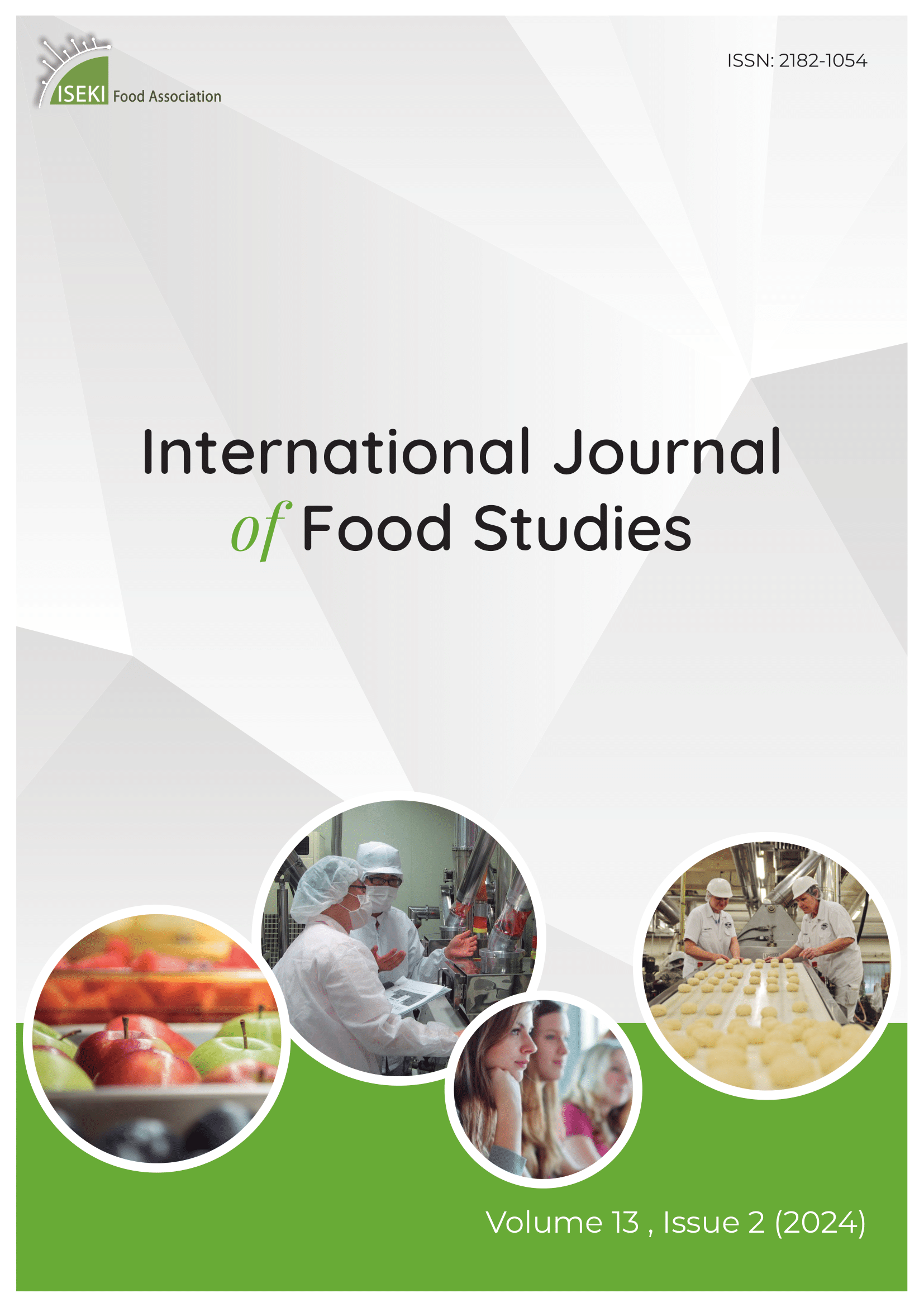Current issue

Volume 13, Issue 2, 2024
Online ISSN: 2182-1054
Volume 13 , Issue 2, (2024)
Published: 18.10.2024.
Open Access
All issues
Contents
01.12.2016.
Professional paper
Impact of selected polyphenolics on the structural properties of model lipid membranes – a review
Nataša P. Ulrih, Ajda Ota, Veronika Abram
01.12.2016.
Professional paper
Cytotoxic, antioxidant and antimicrobial properties of red sweet pepper (Capsicum annuum L. var. Llanerón) extracts: In vitro study
Rosa Raybaudi-Massilia, Alírica I. Suárez, Francisco Arvelo, Alexandra Zambrano, Felipe Sojo, María I. Calderón-Gabaldón, Jonathan Mosqueda-Melgar
01.12.2016.
Professional paper
Evaluation of physical, milling and cooking properties of four new rice (Oryza sativa L.) varieties in Nigeria
Mayowa S. Sanusi, Rahman Akinoso, Nahemiah Danbaba
01.12.2016.
Professional paper
Drying characteristics of zucchini and empirical modeling of its drying process
Naciye Kutlu, Asli Isci
01.12.2016.
Professional paper
Effect of Grewia venusta FRESEN mucilage on the proximate composition, physical and sensory properties of bread produced from wheat and cassava composite flours
Arubi P. Alobo, Gibson L. Arueya
01.12.2016.
Professional paper
Effect of tuna skin gelatin-based coating enriched with seaweed extracts on the quality of tuna fillets during storage at 4 °C
Milene Vala, Ana Augusto, André Horta, Susana Mendes, Maria M. Gil
18.10.2017.
Original scientific paper
Effect of tuna skin gelatin-based coating enriched with seaweed extracts on the quality of tuna fillets during storage at 4 °C
Nowadays, consumers demand high quality food products with an extended shelf-life without chemical additives. Edible coatings (EC) containing natural compounds are a promising preservation technology for raw seafood without compromising fresh-like appeal and nutritional content. The aim of this work was to evaluate the effect of Thunnus obesus skin gelatin-based EC containing Codium spp. or Fucus vesiculosus extracts on raw tuna preservation. Three gelatin-based EC (gelatin (5 %) + glycerol (25 %); gelatin (5 %) + Codium spp. (1 %) + glycerol (25 %); gelatin (5 %) + Fucus vesiculosus (1 %) + glycerol (25 %)) were applied directly on the surface of tuna fillets. Functional properties of gelatin and gelatin-based EC containing seaweed extracts were also studied. The gelatin was extracted by an acid-swelling process in the presence/absence of pepsin, followed by subsequent heating/refrigeration, after a pre-treatment with NaOH. The type of acid, temperature and concentration of NaOH greatly influence the process yield. The higher extraction yield was achieved using acetic acid in the presence of pepsin by subsequent refrigeration, especially when skins were previously treated with NaOH (0.2 M). Tuna quality was assessed over 12 days of storage at 4 ± 1 °C in terms of chemical and microbial indices. Results showed that tuna skin gelatin-based EC avoids tuna deterioration. Microbial growth, assessed by total viable counts, and total volatile basic nitrogen were maintained below the maximum limits recommended, contrarily to the control. Additionally, the use of EC increased the stability of red colour during storage.
Milene Vala, Ana Augusto, Andre Horta, Susana Mendes, Maria M. Gil
18.10.2017.
Original scientific paper
Impact of selected polyphenolics on the structural properties of model lipid membranes – a review
This review is a presentation of data gathered on the interactions of several polyphenolics (i.e., phenolic acids, stilbenes, flavonoids) with lipid bilayers of different lipid compositions. These polyphenolics have been investigated through a combination of fluorescence spectroscopy, electron paramagnetic resonance spectroscopy, and differential scanning calorimetry, to detect changes in membrane fluidity. Among the investigated phenolic acids, the least polar phenolic acid, p-coumaric acid, has the greatest effect on lipid membrane structure. It appears to have a greater ability to cross membranes by passive transport than more polar phenolic acids. On the other hand, among the flavonoids that have been studied, the anthocyanins cyanidin-3-glucoside and its aglycone are inactive. All of the flavonols tested, except for epigallocatechin-3-gallate, promote small decreases in membrane fluidity. Computer simulation of electron paramagnetic resonance spectra for flavonoids indicated two or three regions in the phosphatidylcholine/ phosphatidylserine (2.4:1) membrane with different fluidity characteristics. The effects of the different flavonoids are correlated to their structural characteristics, whereby even the difference in one -OH group can be important, as can the number of H-bonds they form. The role of membrane composition and flavonoid structure in these interactions with lipid membranes are of great importance for bioavailability of these compounds and for their biological effects in an organism.
Natasa Poklar Ulrih, Ajda Ota, Veronika Abram
18.10.2017.
Original scientific paper
Food science and technology students self-evaluate soft and technical skills
Food Scientists and Technologists (FS&T) need diverse skills in the globalized food and drink sector: Food-specific or scientific / technical skills and generic or intuitive soft skills. This study determined how satisfied FS&T students were with overall improvement, and in key technical and soft skills, based on their university work; and if satisfaction was linked to geography, degree in progress, anticipated degree, anticipated work place or anticipated job responsibility. An on-line survey was completed by 267 students in over 20 countries using a 5-point Likert scale to evaluate satisfaction. Responses were analyzed by the Friedman or Kruskal Wallis tests for more than two groups, otherwise by the Wilcoxon Signed Rank or Mann-Whitney tests. There were no differences in Overall Satisfaction with technical and soft skills training. Among soft skills, training in Working with Others and Being Responsible were more often rated “Excellent” and students were more satisfied with their training than with Solving Problems, Communication and Positive Attitude. Students anticipating a job with high responsibility were more satisfied with overall soft skill training and with 3 of the 5 specific soft skills. Among technical skills, students were more satisfied with improvement in basic sciences (Microbiology, Chemistry, Processing, Safety), and those in Northern Europe were more satisfied with overall technical training. These data show variations in perception and/or efficacy of technical and soft skill training in Food Science programmes and underline the need for separate attention to the incorporation of soft skill training into the design of FS&T courses.
Katherine M. Flynn, Peter Ho, Margarida C. Vieira, Paola Pittia, Marco Dalla Rosa
18.10.2017.
Original scientific paper
Effect of Grewia venusta FRESEN mucilage on the proximate composition, physical and sensory properties of bread produced from wheat and cassava composite flours
Wheat and cassava composite breads are generally associated with volume and textural defects in contrast with the traditional wheat based variants. Efforts to mitigate this challenge through use of synthetic additives have been unsuccessful owing to safety concerns. The objective of this study was to explore Grewia venusta mucilage as a potential natural additive in wheat-cassava composite bread production. Sweet cassava flour was used to replace wheat flour at 100: 0 (control), 90:10, 80:20 and 70:30% ratios in bread making. Aqueous extract of G. venusta stem bark was oven dried (50±3 °C), milled and added at 0, 1.0 and 2.0% (w/w) to the flour mixtures. These, along with other conventional inputs were mixed, and used to produce bread. Proximate compositions, physical and sensory properties of the bread loaves were evaluated. Cassava flour inclusion resulted in significant (P≤0.05) decrease in the protein content of the control from 18.1% to 12.1% (90:10%), 11.5% (80:20%) and 9.9% (70:30%). Addition of mucilage marginally increased the protein and dietary fibre contents of the loaves. Loaves containing 1-2% mucilage were more regular in shape with smoother crust than those without mucilage. Cassava flour addition at 10%, 20% and 30% decreased loaf height from 6.0 cm to 5.8 cm, 5.7 cm and 5.5 cm, as well as loaf volume from 815.5 cm3 to 783.1 cm3 , 776.8 cm3 and 744.5 cm3 , respectively. Mucilage inclusion resulted in increased heights and volumes of the loaves and reduced weights of loaf fragments upon slicing. The mucilage significantly improved the texture of the bread loaves.
Arubi P. Alobo, Gibson L. Arueya











